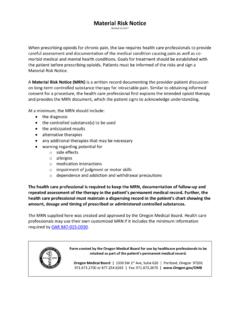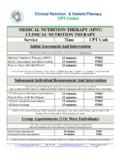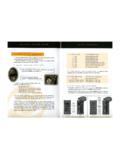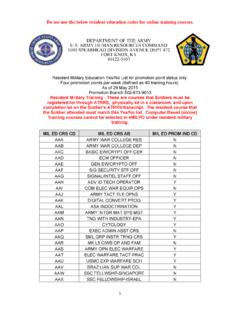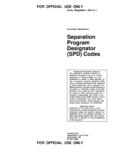Transcription of THE NATIONAL ACADEMIES PRESS - oregon.gov
1 DETAILSD istribution, posting, or copying of this PDF is strictly prohibited without written permission of the NATIONAL ACADEMIES PRESS . (Request Permission) Unless otherwise indicated, all materials in this PDF are copyrighted by the NATIONAL Academy of NATIONAL Academy of Sciences. All rights NATIONAL ACADEMIES PRESSV isit the NATIONAL ACADEMIES PRESS at and login or register to get: Access to free PDF downloads of thousands of scientific reports 10% off the price of print titles Email or social media notifications of new titles related to your interests Special offers and discounts GET THIS BOOKFIND RELATED TITLESThis PDF is available at SHARECONTRIBUTORS and Potential Impacts of AFFF Containing PFASs atAirports222 pages | x 11 | PAPERBACKISBN 978-0-309-44638-9 | DOI H.
2 Thalheimer, Leah B. McConney, Indra K. Kalinovich, Anne V. Pigott,Jennifer D. Franz, Heather Taylor Holbert, Dean Mericas, and Zachary ; Airport Cooperative Research Program; Transportation Research Board; NATIONAL ACADEMIES of Sciences, Engineering, and MedicineAIRPORT COOPERATIVE RESEARCH PROGRAMACRP RESEARCH REPORT 1732017 Research sponsored by the Federal Aviation AdministrationSubscriber CategoriesAviation EnvironmentUse and Potential Impacts of AFFF Containing PFASs at AirportsAndrew H. ThalheimerLeah B. McConneyDillon Consulting limiteDHalifax, NS, CanadaIndra K.
3 KalinovichDillon Consulting limiteDWinnipeg, MB, CanadaAnne V. PigottDillon Consulting limiteDVancouver, BC, CanadaJennifer D. FranzHeather Taylor HolbertJD Franz researCh, , CADean MericasmeaD & hunt, , TXZachary J. PuchaczmeaD & hunt, , MIUse and Potential Impacts of AFFF Containing PFASs at AirportsCopyright NATIONAL Academy of Sciences. All rights COOPERATIVE RESEARCH PROGRAMA irports are vital NATIONAL resources. They serve a key role in trans-portation of people and goods and in regional, NATIONAL , and interna-tional commerce.
4 They are where the nation s aviation system connects with other modes of transportation and where federal responsibility for managing and regulating air traffic operations intersects with the role of state and local governments that own and operate most airports. Research is necessary to solve common operating problems, to adapt appropriate new technologies from other industries, and to introduce innovations into the airport industry. The Airport Cooperative Research Program (ACRP) serves as one of the principal means by which the airport industry can develop innovative near-term solutions to meet demands placed on need for ACRP was identified in TRB Special Report 272: Airport Research Needs: Cooperative Solutions in 2003, based on a study spon-sored by the Federal Aviation Administration (FAA).
5 ACRP carries out applied research on problems that are shared by airport operating agen-cies and not being adequately addressed by existing federal research programs. ACRP is modeled after the successful NATIONAL Cooperative Highway Research Program (NCHRP) and Transit Cooperative Research Program (TCRP). ACRP undertakes research and other technical activi-ties in various airport subject areas, including design, construction, legal, maintenance, operations, safety, policy, planning, human resources, and administration. ACRP provides a forum where airport operators can cooperatively address common operational was authorized in December 2003 as part of the Vision 100 Century of Aviation Reauthorization Act.
6 The primary participants in the ACRP are (1) an independent governing board, the ACRP Oversight Committee (AOC), appointed by the Secretary of the Department of Transportation with representation from airport operating agencies, other stakeholders, and relevant industry organizations such as the Airports Council International-North America (ACI-NA), the American Associa-tion of Airport Executives (AAAE), the NATIONAL Association of State Aviation Officials (NASAO), Airlines for America (A4A), and the Airport Consultants Council (ACC) as vital links to the airport community; (2) TRB as program manager and secretariat for the governing board; and (3) the FAA as program sponsor.
7 In October 2005, the FAA executed a contract with the NATIONAL Academy of Sciences formally initiating the benefits from the cooperation and participation of airport professionals, air carriers, shippers, state and local government officials, equipment and service suppliers, other airport users, and research organi-zations. Each of these participants has different interests and responsibili-ties, and each is an integral part of this cooperative research problem statements for ACRP are solicited periodically but may be submitted to TRB by anyone at any time.
8 It is the responsibility of the AOC to formulate the research program by identifying the highest priority projects and defining funding levels and expected selected, each ACRP project is assigned to an expert panel appointed by TRB. Panels include experienced practitioners and research specialists; heavy emphasis is placed on including airport professionals, the intended users of the research products. The panels prepare project statements (requests for proposals), select contractors, and provide technical guidance and counsel throughout the life of the project.
9 The process for developing research problem statements and selecting research agencies has been used by TRB in managing coop-erative research programs since 1962. As in other TRB activities, ACRP project panels serve voluntarily without emphasis is placed on disseminating ACRP results to the intended users of the research: airport operating agencies, service pro-viders, and academic institutions. ACRP produces a series of research reports for use by airport operators, local agencies, the FAA, and other interested parties; industry associations may arrange for workshops, training aids, field visits, webinars, and other activities to ensure that results are implemented by airport industry RESEARCH REPORT 173 Project 02-60 ISSN 2572-3731 (Print) ISSN 2572-374X (Online) ISBN 978-0-309-44638-9 Library of Congress Control Number 2017939583 2017 NATIONAL Academy of Sciences.
10 All rights INFORMATIONA uthors herein are responsible for the authenticity of their materials and for obtaining written permissions from publishers or persons who own the copyright to any previously published or copyrighted material used herein. Cooperative Research Programs (CRP) grants permission to reproduce material in this publication for classroom and not-for-profit purposes. Permission is given with the understanding that none of the material will be used to imply TRB, AASHTO, FAA, FHWA, FMCSA, FRA, FTA, Office of the Assistant Secretary for Research and Technology, PHMSA, or TDC endorsement of a particular product, method, or practice.









